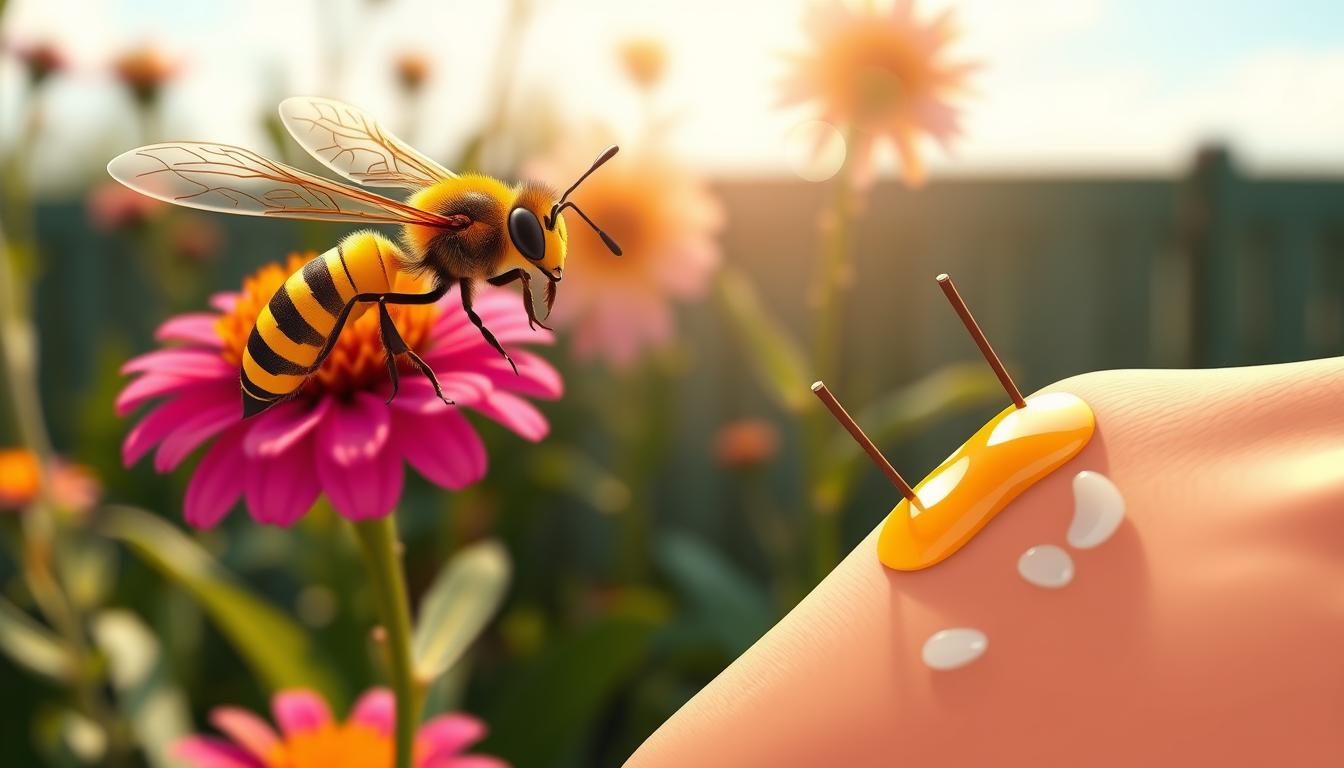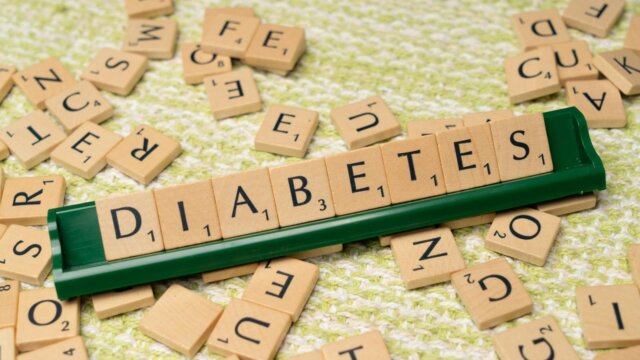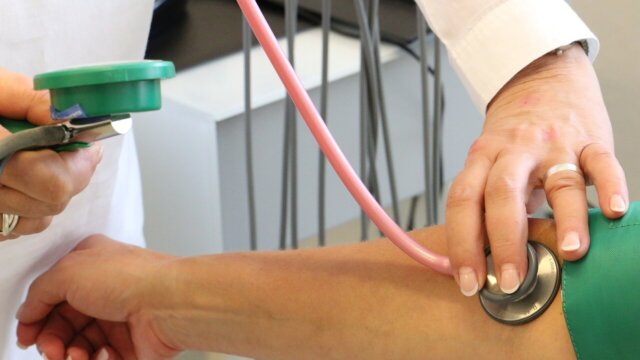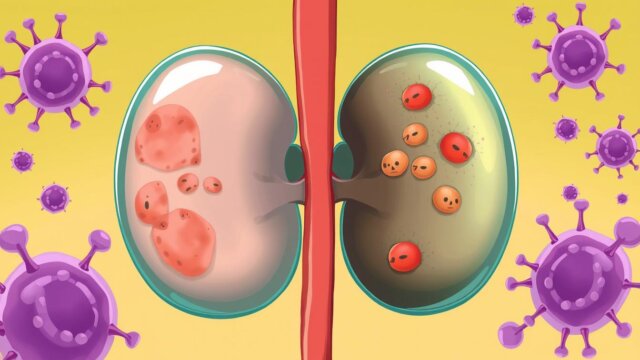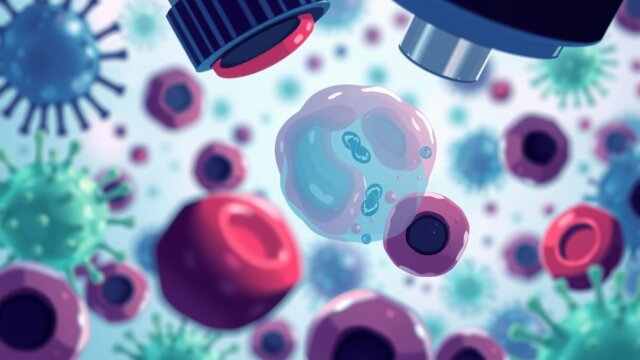FTC disclaimer: This post may contains affiliate links and we will be compensated if you click on a link and make a purchase.
Every year, 62 Americans die from hornet, wasp, and bee stings, the CDC says. These small insects can cause a lot of pain, swelling, and even serious allergic reactions. If you get stung by a yellow jacket, don’t worry. There are home remedies that can help.
Yellow jackets are known for their aggressive behavior and painful stings. They are different from bees because they attack in groups if their nest is threatened. Knowing how to treat a yellow jacket sting can help reduce pain and prevent serious problems.
Key Takeaways
- Yellow jacket stings can cause severe pain, swelling, redness, and itching due to the venom they inject.
- Home remedies like baking soda paste, cold compresses, and natural oils can help soothe yellow jacket sting symptoms.
- Proper first aid, including removing the stinger and cleaning the area, is crucial for preventing infection.
- Individuals with known allergies to insect stings should carry an EpiPen and seek immediate medical attention for severe reactions.
- Taking preventive measures, such as avoiding scented items and staying away from yellow jacket nests, can help reduce the risk of being stung.
Understanding Yellow Jacket Stings
Yellow jackets are aggressive and territorial. Their stings cause pain, swelling, and itching. The reaction can be mild or severe.
Symptoms and Causes
Most stings cause pain and swelling at the site. But, some may have a severe reaction called anaphylaxis. This can make it hard to breathe and needs quick medical help.
Yellow jackets can sting many times because they don’t leave their stingers in the skin.
Distinguishing Between Local and Severe Reactions
Symptoms of a big local reaction usually show up 48 to 72 hours after the sting. But, if you have trouble breathing or feel confused after a sting, get help fast. Also, if you’ve had a bad reaction before, call 911 if you get stung again soon.
Symptom | Severity | Action |
|---|---|---|
Localized pain, swelling, and redness | Mild to moderate | Treat with home remedies |
Difficulty breathing, swelling in the throat, confusion | Severe (anaphylaxis) | Seek immediate medical attention |
Past severe allergic reaction, stung less than 2 hours ago | Severe | Call 911 |
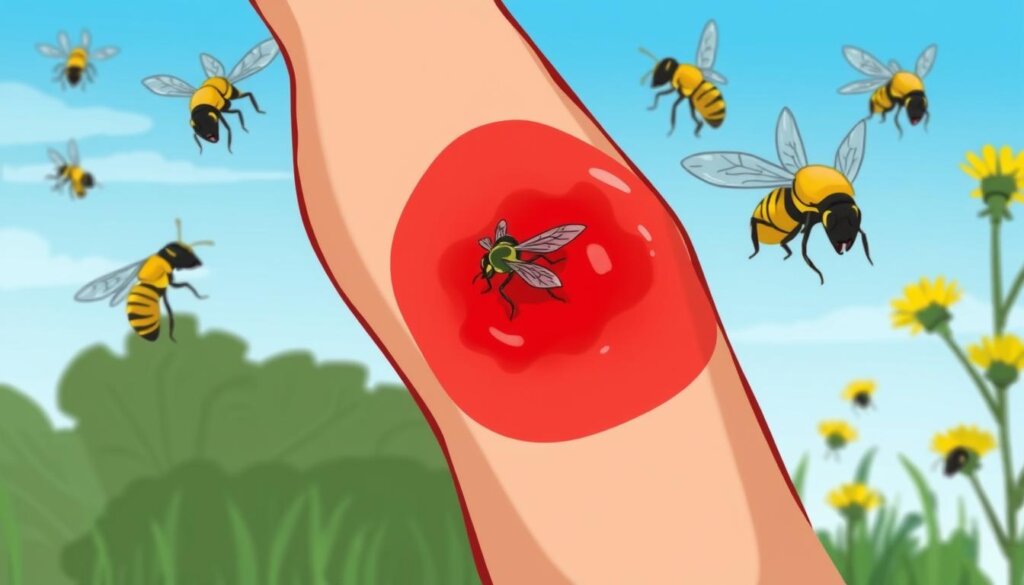
Immediate First Aid for Yellow Jacket Stings
Removing the Stinger
If you see a stinger after a sting, take it out fast. Use a straight edge, like a credit card or butter knife, to carefully remove it. Don’t squeeze the skin, as it can make the venom spread and make it worse.
Cleaning the Sting Site
After taking out the stinger, wash the area with soap and warm water. This gets rid of any venom left and lowers infection risk. Clean it gently, without hurting the skin more.
Quick first aid for yellow jacket stings is key to avoid problems and help it heal. By removing the stinger and cleaning the area, you can lessen pain, swelling, and infection risk. If you have severe symptoms like trouble breathing, get medical help right away.

By following these easy steps, you can give good first aid for yellow jacket stings and help it heal fast. It’s also smart to be careful and try to avoid yellow jacket runs-in in the first place.
“Immediate medical attention is advised for severe reactions to stings, such as intense pain, difficulty breathing, swelling of lips, eyelids, or throat, dizziness, rapid heartbeat, hives, nausea, cramps, or vomiting.”
Baking Soda Paste: A Natural Remedy
Baking soda can help with yellow jacket sting pain. Mix a teaspoon of baking soda with a bit of water to make a paste. This is a simple home remedy.
Apply the paste to the sting area. It can lessen pain, swelling, and itching. Baking soda’s anti-inflammatory properties help fight the venom.
The paste draws out venom, easing burning and swelling. For the best effect, keep it on for 5-10 minutes then rinse. This natural method can greatly help with yellow jacket sting discomfort.
Other household items can also treat yellow jacket stings. Raw honey on the sting for 30 minutes can neutralize venom and ease pain. Vinegar, white or apple cider, can also reduce inflammation and offer relief.
While these remedies are useful, watch for infection signs. If symptoms worsen, see a doctor. Having these natural solutions ready can help you quickly manage yellow jacket sting discomfort.
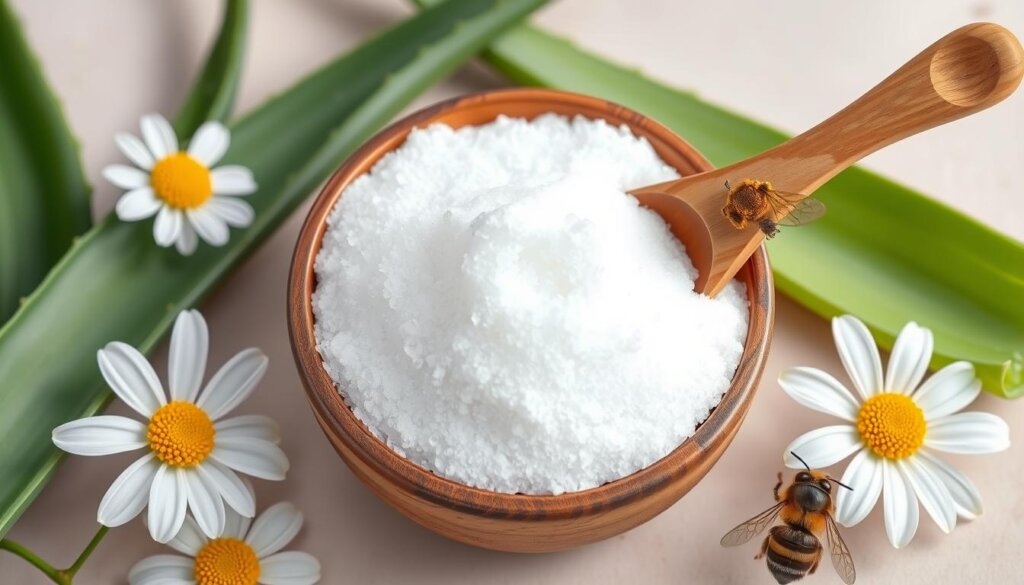
Cold Compress: Reducing Pain and Swelling
A cold compress is great for yellow jacket sting pain. It makes blood vessels smaller and slows down swelling. This helps reduce pain and swelling at the sting site.
Use a cold pack or ice in a towel for 30 to 60 minutes. Do this in 10-minute intervals to get relief.
Cold compresses are a simple but effective way to treat yellow jacket stings. They help with pain and swelling, which usually go away in a day with home treatment. Applying a cold compress can make you feel better and heal faster.
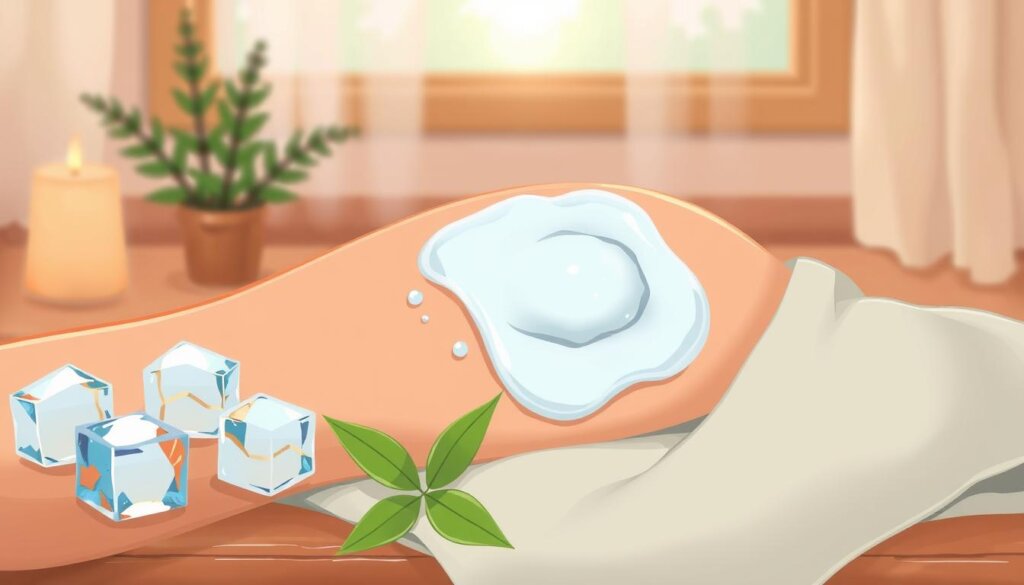
If a sting happens in your mouth, nose, or throat, get medical help right away. These areas can swell fast, which might block your breathing. Knowing the symptoms and acting fast is key to getting better from a yellow jacket sting.
Home Remedies for Yellow Jacket Stings
Honey: Nature’s Venom Neutralizer
If you’re looking for a natural remedy for yellow jacket stings, try honey. Raw honey is great for soothing stings. It can neutralize the venom and make the pain, itching, and swelling go away. Plus, its antimicrobial qualities help with wound healing.
Vinegar: Combating Inflammation
Vinegar is also good for yellow jacket stings. You can use white vinegar or apple cider vinegar. Mix it with water and put it on the sting. The anti-inflammatory properties of vinegar can make swelling and discomfort better.
Home Remedy | Active Ingredients | Proposed Benefits |
|---|---|---|
Honey | Antimicrobial, anti-inflammatory compounds | Neutralize venom, reduce pain and swelling, promote healing |
Vinegar | Acetic acid, anti-inflammatory properties | Reduce inflammation, alleviate swelling and discomfort |
“Honey and vinegar are two of the most effective natural remedies for soothing yellow jacket stings. They work in different ways to provide relief and promote healing.”
Activated Charcoal: Drawing Out the Venom
If you’ve been stung by a yellow jacket, try a paste of activated charcoal and water. It’s a good home remedy to draw out the venom. Activated charcoal works like a magnet, pulling out the venom and making the sting less bad.
Activated charcoal is great for detoxifying and can help with yellow jacket stings. One person used it with tea tree oil and Vicks vapor rub. It helped a lot with allergic reactions and even kept them from needing the hospital.
To use it, mix activated charcoal with water to make a thick paste. Put it on the sting and leave it for 15-20 minutes. It will help pull out the venom, easing pain, swelling, and itching. You can use it again if the symptoms come back.
Activated charcoal is a natural and safe way to deal with yellow jacket stings. It helps pull out the venom, giving you relief and avoiding serious problems.
Ammonia: Relieving Itching
For itching from a yellow jacket sting, try ammonia. It’s a common item that helps a lot. Just put a little ammonia on the sting to feel better fast.
Ammonia fights the venom that makes you itch. It works right away, making it a great home fix for sting itch.
But, watch the sting for signs of infection. If it gets worse, hurts more, or has pus, see a doctor.
Ammonia is a simple yet powerful tool in your arsenal against the discomfort of yellow jacket stings. Its ability to neutralize the venom and alleviate the itching makes it a go-to home remedy for quick and effective relief.
“Ammonia is a game-changer when it comes to soothing yellow jacket sting irritation. Its venom-neutralizing properties provide almost instant relief.”
Epsom Salt Bath: Soothing Relief
An Epsom salt bath can really help with yellow jacket sting relief. The magnesium in Epsom salts helps reduce swelling and pain. It’s a cheap and effective way to soothe the sting area.
To make an Epsom salt bath, add lots of Epsom salts to warm water. Soak the sting area for 15-20 minutes. The warm water and Epsom salts relax muscles, remove toxins, and help heal.
But, watch for signs of infection or bad reactions. Look out for skin issues, swelling, trouble breathing, or severe pain. If you see these, get medical help fast. Call 9-1-1 for fast pulse, dizziness, nausea, or bad reactions to stings before.
Using an Epsom salt bath can lessen pain and swelling. It helps your body heal naturally. But, if reactions are severe, see a doctor right away.
“An Epsom salt bath can be a true lifesaver when dealing with the discomfort of yellow jacket stings. The soothing relief it provides is unmatched.”
An Epsom salt bath is a good natural and affordable way to ease yellow jacket sting pain. It uses magnesium to reduce swelling and pain. Just remember, if reactions are bad, you need to see a doctor.
Home Remedy | Key Benefits | Considerations |
|---|---|---|
Epsom Salt Bath |
|
|
Meat Tenderizer: Enzymatic Venom Neutralization
If you’ve been stung by a yellow jacket, meat tenderizer might help. It has enzymes that can neutralize the venom. This can make the pain and swelling go down.
To use it, mix meat tenderizer with a bit of water to make a paste. Put the paste on the sting and rub it in gently. The enzymes in the tenderizer break down the venom. This can make you feel better and reduce swelling.
Benefits of Using Meat Tenderizer | Drawbacks of Using Meat Tenderizer |
|---|---|
|
|
Meat tenderizer can help with a yellow jacket sting, but it’s not a cure-all. It doesn’t fix the venom allergy. If you have a bad reaction, like anaphylaxis, get help right away. It’s a quick fix, not a long-term solution.
How well meat tenderizer works can differ from person to person. Always test it on a small area first. It can be a helpful tool for yellow jacket stings.
Salt Paste: Another Venom-Drawing Remedy
If you’ve been stung by a yellow jacket, a salt paste can help. The salt’s absorbent properties work to pull out the venom. This makes the sting less painful.
To make the paste, mix one part salt with two parts water. You’ll get a thick paste. Apply it to the sting and wait 20 minutes before washing it off.
This natural detoxification helps draw out the venom. It also eases sting-related pain and swelling.
Adding a few drops of witch hazel to the paste can make it even better. Witch hazel helps reduce swelling and irritation from bites and stings.
While salt paste can help, watch the sting site for infection signs. If you see any, get medical help. With a bit of salt and patience, you can ease the sting’s effects.
Leek Leaf: A Surprising Natural Treatment
Many people don’t think of leek leaves for yellow jacket stings. But, this simple plant can really help. Leek leaves have natural anti-inflammatory properties that fight swelling and irritation from yellow jacket venom.
To use leek leaves, just split a fresh one and put it on the sting. The leaf’s cooling effect and active compounds can ease the pain. This unique home remedy is a surprising but effective way to deal with yellow jacket stings.
Leek leaves have been used for healing for centuries. In the 19th-century book “Herbal Simples Approved for Modern Uses of Cure,” it talks about using herbs for healing. It even mentions a story of Iapis, a pupil of Apollo, who saved Aeneas with the herb “Dittany.”
Even with modern medicine, traditional herbal remedies still have a lot to offer. The Leek Leaf for Sting Relief shows how plants can have Natural Anti-inflammatory properties. It also highlights the Unique Home Remedy solutions found in nature.
So, if you get stung by a yellow jacket, try using a fresh leek leaf. This surprising natural treatment might be just what you need.
Home Remedies for Yellow Jacket Stings
There are many home remedies for yellow jacket stings. These natural treatments can help ease the pain and speed up healing. Yellow jackets are thin wasps with black and yellow stripes and long dark wings. They are different from bees, which are rounder. Yellow jackets can sting multiple times and their venom causes sudden pain.
After a sting, you might feel inflammation, redness, and itching. You could also feel tired or have warmth at the sting site. If you have trouble breathing or your skin changes, seek help right away. Some people might have a severe allergic reaction called anaphylaxis.
Here are some home remedies to help:
- Baking soda paste: Mix baking soda and water to neutralize venom and reduce swelling and itching.
- Cold compress: Use a cold compress to ease pain and swelling.
- Honey: Raw honey has antibacterial and anti-inflammatory properties that can soothe the sting.
- Vinegar: Vinegar’s acetic acid can counteract the venom’s alkalinity.
- Activated charcoal: Apply a charcoal paste to draw out venom and toxins.
- Ammonia: Rubbing a bit of household ammonia on the sting can help with itching.
- Epsom salt bath: Soaking in an Epsom salt bath can provide soothing relief.
- Meat tenderizer: The enzymes in meat tenderizer can break down venom proteins.
- Salt paste: A salt and water paste can also draw out venom.
- Leek leaf: Applying a fresh leek leaf to the sting site is a surprising natural treatment.
Using these natural remedies can help ease yellow jacket sting discomfort and aid in healing.
“Home remedies can be a safe and effective way to manage the symptoms of yellow jacket stings, providing relief while avoiding the potential side effects of medications.”
Home Remedy | Benefits |
|---|---|
Baking Soda Paste | Neutralizes venom, reduces swelling and itching |
Cold Compress | Alleviates pain and inflammation |
Honey | Natural antibiotic and anti-inflammatory properties |
Vinegar | Counteracts the alkalinity of yellow jacket venom |
Activated Charcoal | Draws out venom and toxins |
Ammonia | Relieves itching |
Epsom Salt Bath | Provides soothing relief |
Meat Tenderizer | Breaks down venom proteins |
Salt Paste | Draws out venom |
Leek Leaf | Surprising natural treatment option |
While these home remedies can help, seek medical help if symptoms worsen or if you have severe reactions. To avoid stings, cover food, wear protective clothes, and avoid sweet foods and perfumes.
Preventing and Treating Infections
Yellow jacket stings usually don’t get infected. But, if the sting site isn’t cleaned well or gets scratched too much, it can get infected. Look out for signs like more pain, swelling, redness, pus, and fever. If you see these, get medical help right away.
If you have a bad reaction, like trouble breathing or swelling in your throat, call 911. Go to the emergency room fast. Also, if the sting site gets infected or the pain and swelling get worse, see a doctor. They might give you antibiotics for a Secondary Bacterial Infection.
Watching the sting site closely and acting fast can stop problems. Always choose to be safe and get medical advice if you’re worried. The Mayo Clinic has great tips on dealing with insect bites and stings. Most reactions to bee stings are local. But, some can be toxic or anaphylactic, which are rare.
Pain and swelling are common after a bee sting. You might also feel itchy or have a burning feeling. Yellow jackets, hornets, and wasps can also cause allergic reactions like bee stings. If you have a severe reaction, you might need emergency care like CPR or epinephrine.
It’s key to prevent and treat infections from yellow jacket stings. By knowing the signs of infection and getting help when needed, you can avoid serious problems. Following good first aid can help you heal faster.
First Aid Kit Essentials for Yellow Jacket Stings
It’s important to be ready for yellow jacket stings. These insects can give painful venom. Up to 0.8 percent of kids and 3 percent of adults have allergies to wasp stings. Keep a first aid kit ready for any sting emergencies.
Here are the must-haves for your first aid kit:
- Alcohol wipes to clean the sting site
- Hydrogen peroxide to prevent infection
- Antihistamine tablets for swelling and allergies
- An EpiPen for severe allergies
Having these items ready can help quickly treat symptoms. Anaphylaxis from wasp venom can cause serious symptoms like swelling and breathing trouble. Being prepared can save lives.
Remember, some people may face serious or life-threatening reactions to bee or wasp stings. Having the right first aid can help manage any sting reaction.
Item | Purpose |
|---|---|
Alcohol Wipes | Disinfect the sting site |
Hydrogen Peroxide | Clean and help prevent infection |
Antihistamine Tablets | Reduce swelling and allergic reactions |
EpiPen | Treat severe allergic reactions |
Conclusion
Yellow jacket stings can hurt a lot and might be dangerous. But, knowing how to handle them can make a big difference. Home remedies like baking soda and cold compresses can help a lot. They can also use honey and activated charcoal to fight the venom.
It’s very important to avoid getting stung by yellow jackets. Some people might have a bad allergic reaction. If you’re allergic, getting stung again could be even worse. If you have a bad reaction, you need to see a doctor right away. This is because stings can be deadly for kids, and you might need more help.
By using these tips, you can stay safe from yellow jacket stings. Keep a first aid kit ready for emergencies. This way, you can enjoy the outdoors without worry. Remember, knowing how to treat stings is key to staying safe and healthy.
FAQ
What are the symptoms of a yellow jacket sting?
Yellow jacket stings can cause severe pain, swelling, redness, and itching. The venom they inject into the skin is what causes these symptoms.
How do yellow jacket stings differ from bee stings?
Yellow jacket stings are often confused with bee stings. But yellow jackets are much more aggressive in nature.
What are the different types of reactions to yellow jacket stings?
Most yellow jacket stings cause pain, swelling, and redness at the sting site. But, some people may have a severe reaction called anaphylaxis. This needs immediate medical attention.
How should I remove a yellow jacket stinger?
If a stinger is left behind, use a straight edge to gently scrape it away. Avoid squeezing the skin to prevent more venom from being released.
How can baking soda help soothe a yellow jacket sting?
Mix a teaspoon of baking soda with water to make a paste. Apply it to the affected area to reduce pain, swelling, and itching. Baking soda neutralizes venom and has anti-inflammatory properties.
How can a cold compress help with yellow jacket stings?
A cold compress or ice pack can help with pain and swelling. Cold temperatures constrict blood vessels and slow inflammation.
What other home remedies can help soothe yellow jacket stings?
Honey, vinegar, activated charcoal, ammonia, Epsom salt baths, meat tenderizer, salt paste, and leek leaf are effective. They help neutralize venom, reduce inflammation, and relieve symptoms.
How can I tell if a yellow jacket sting is infected?
Signs of infection include increased pain, swelling, redness, pus, and fever. Watch the sting site and seek medical help if you see these signs.
When should I seek medical attention for a yellow jacket sting?
Seek immediate medical attention for severe allergic reactions like difficulty breathing or swelling in the throat. Also, if the sting site becomes infected or symptoms worsen, get medical help.
What should I keep in my first aid kit for yellow jacket stings?
Keep alcohol, hydrogen peroxide, antihistamine tablets, and an EpiPen in your first aid kit. These items can help manage symptoms and respond to emergencies.
